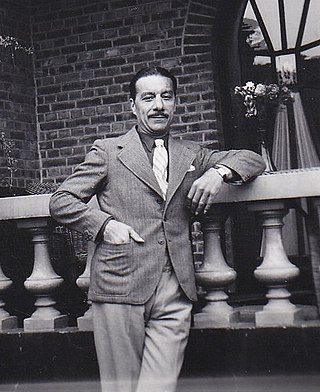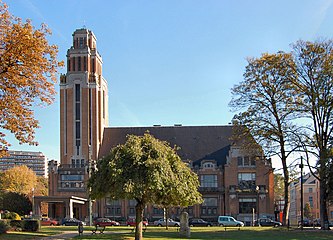
Victor Pierre Horta was a Belgian architect and designer, and one of the founders of the Art Nouveau movement. He was a fervent admirer of the French architectural theorist Eugène Viollet-le-Duc and his Hôtel Tassel in Brussels (1892–93), often considered the first Art Nouveau house, is based on the work of Viollet-le-Duc. The curving stylized vegetal forms that Horta used in turn influenced many others, including the French architect Hector Guimard, who used it in the first Art Nouveau apartment building he designed in Paris and in the entrances he designed for the Paris Metro. He is also considered a precursor of modern architecture for his open floor plans and his innovative use of iron, steel and glass.
Paul Saintenoy was a Belgian architect, teacher, architectural historian, and writer.

Ixelles or Elsene is one of the 19 municipalities of the Brussels-Capital Region, Belgium. Located to the south-east of Brussels' city centre, it is geographically bisected by the City of Brussels. It is also bordered by the municipalities of Auderghem, Etterbeek, Forest, Uccle, Saint-Gilles and Watermael-Boitsfort.

The Centre for Fine Arts is a multi-purpose cultural venue in the Royal Quarter of Brussels, Belgium. It is often referred to as BOZAR in French or by its initials PSK in Dutch. This multidisciplinary space was designed to bring together a wide range of artistic events, whether music, visual arts, theatre, dance, literature, cinema or architecture.

The Hôtel Tassel is a historic town house in Brussels, Belgium. It was designed by Victor Horta for the scientist and professor Emile Tassel, and built between 1892 and 1893, in Art Nouveau style. It is considered one of the first buildings in that style because of its highly innovative plan and its ground-breaking use of materials and decoration. It is located at 6, rue Paul-Emile Janson/Paul-Emile Jansonstraat, a few steps from the Avenue Louise/Louizalaan.

The Avenue Louise or Louizalaan (Dutch) is a major thoroughfare in Brussels, Belgium. It is located in the southern part of the City of Brussels, on the border with the municipalities of Saint-Gilles and Ixelles, where it runs south–east from the Place Louise/Louizaplein to the Bois de la Cambre/Ter Kamerenbos, covering a distance of 2.7 km (1.7 mi). It is named in honour of both Queen Louise, the first Queen of the Belgians and wife of King Leopold I, and Princess Louise, King Leopold II's eldest daughter.

The Place Eugène Flagey or Eugène Flageyplein (Dutch), usually shortened to the Place Flagey, or Flagey by locals, is a square in the Ixelles municipality of Brussels, Belgium. It bears the name of a former mayor of Ixelles, Eugène Flagey.

The Horta Museum is a museum in Brussels, Belgium, dedicated to the life and work of the architect Victor Horta and his time. The museum is housed in Horta's former town house and workshop, built between 1898 and 1901, in Art Nouveau style. It is located at 23–25, rue Américaine/Amerikaansestraat in the municipality of Saint-Gilles.

Henri van Dievoet was a Belgian architect.

The major town houses of Victor Horta are four town houses in Brussels, Belgium, which have been listed as a UNESCO World Heritage Site since 2000. All four houses were designed and built by the Belgian architect Victor Horta (1861–1947), who pioneered the Art Nouveau style during the mid-1890s.

The Avenue de Tervueren or Tervurenlaan is a major thoroughfare in Brussels, Belgium. It was originally commissioned by King Leopold II as part of his building campaign, and was finished in 1897, in time for the Brussels International Exhibition of that year.

The Putterie or Putterij is a former quarter of central Brussels, Belgium. The district was centred around Saint Mary Magdalene's Church, between the Rue de la Montagne/Bergstraat, the Rue de la Madeleine/Magdalenastraat and the current Boulevard de l’Impératrice/Keizerinlaan. It was largely destroyed starting in the 1920s with the works of the North–South connection, a major railway link through central Brussels, to develop the area for Brussels-Central railway station and other modern office buildings. Many historic structures were lost in the demolition process.

The Municipal Hall of Forest is the municipal hall building and the seat of that municipality of Brussels, Belgium. Built between 1935 and 1938, and qualified as a prototype of Brussels' Art Deco, this building illustrates the leading role the style played in public architecture during the interwar period.

The Place de Brouckère or De Brouckèreplein (Dutch) is a major square in central Brussels, Belgium. It was created following the covering of the river Senne (1867–1871), replacing the Temple of the Augustinians, which was demolished in 1893. It is named in honour of Charles de Brouckère, a former mayor of the City of Brussels and professor at the Free University of Brussels, who played a great political role during the Belgian Revolution of 1830. The square measures approximately 50 by 350 metres and is nearly entirely paved.

The Art Nouveau movement of architecture and design first appeared in Brussels, Belgium, in the early 1890s, and quickly spread to France and to the rest of Europe. It began as a reaction against the formal vocabulary of European academic art, eclecticism and historicism of the 19th century, and was based upon an innovative use of new materials, such as iron and glass, to open larger interior spaces and provide maximum light; curving lines such as the whiplash line; and other designs inspired by plants and other natural forms.

The Boulevard Adolphe Max or Adolphe Maxlaan (Dutch) is a central boulevard in Brussels, Belgium. It was created following the covering of the river Senne (1867–1871), and bears the name of Adolphe Max, a former mayor of the City of Brussels.
The Timeline of Art Nouveau shows notable works and events of Art Nouveau as well as of local movements included in it.

Antoine Varlet was a Belgian architect. He specialised in luxury apartment buildings in Beaux-Arts and later Art Deco styles.

The Place Charles Rogier or Karel Rogierplein (Dutch), usually shortened to the Place Rogier, or Rogier by locals, is a major square in the Saint-Josse-ten-Noode municipality of Brussels, Belgium. It is named in honour of Charles Rogier, a former Prime Minister of Belgium who played a great political role during the Belgian Revolution of 1830.

Michel Polak was a Belgian-Swiss architect.



































